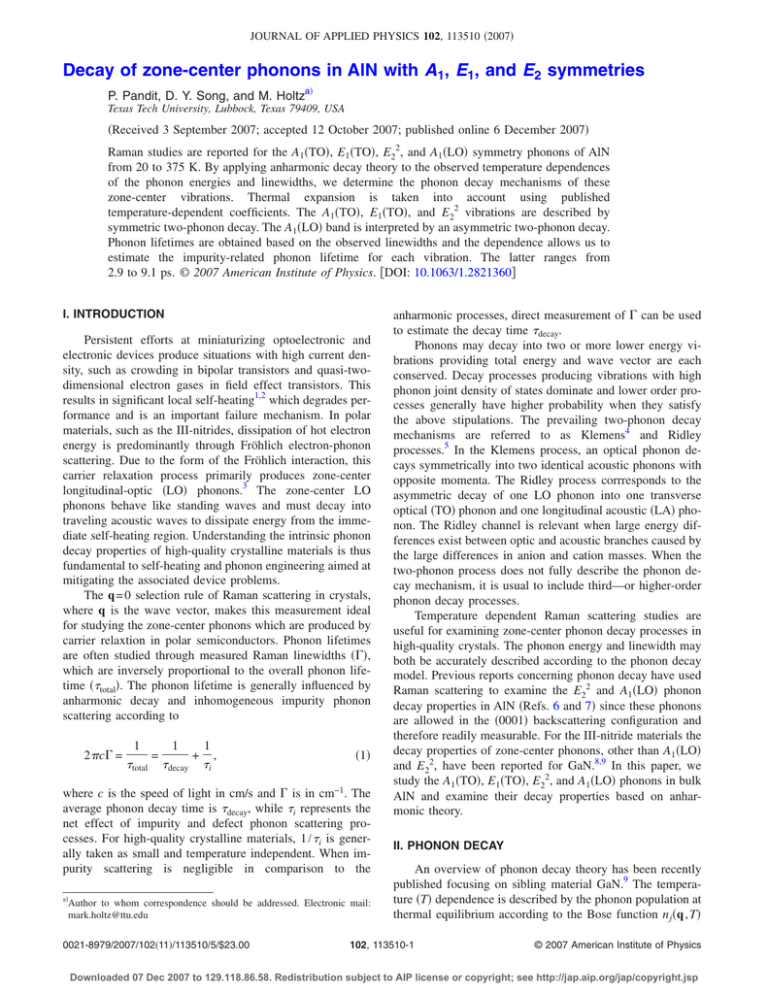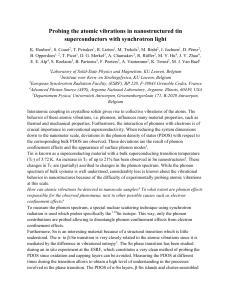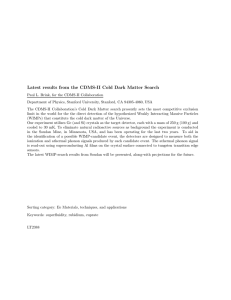A E symmetries
advertisement

JOURNAL OF APPLIED PHYSICS 102, 113510 共2007兲 Decay of zone-center phonons in AlN with A1, E1, and E2 symmetries P. Pandit, D. Y. Song, and M. Holtza兲 Texas Tech University, Lubbock, Texas 79409, USA 共Received 3 September 2007; accepted 12 October 2007; published online 6 December 2007兲 Raman studies are reported for the A1共TO兲, E1共TO兲, E22, and A1共LO兲 symmetry phonons of AlN from 20 to 375 K. By applying anharmonic decay theory to the observed temperature dependences of the phonon energies and linewidths, we determine the phonon decay mechanisms of these zone-center vibrations. Thermal expansion is taken into account using published temperature-dependent coefficients. The A1共TO兲, E1共TO兲, and E22 vibrations are described by symmetric two-phonon decay. The A1共LO兲 band is interpreted by an asymmetric two-phonon decay. Phonon lifetimes are obtained based on the observed linewidths and the dependence allows us to estimate the impurity-related phonon lifetime for each vibration. The latter ranges from 2.9 to 9.1 ps. © 2007 American Institute of Physics. 关DOI: 10.1063/1.2821360兴 I. INTRODUCTION Persistent efforts at miniaturizing optoelectronic and electronic devices produce situations with high current density, such as crowding in bipolar transistors and quasi-twodimensional electron gases in field effect transistors. This results in significant local self-heating1,2 which degrades performance and is an important failure mechanism. In polar materials, such as the III-nitrides, dissipation of hot electron energy is predominantly through Fröhlich electron-phonon scattering. Due to the form of the Fröhlich interaction, this carrier relaxation process primarily produces zone-center longitudinal-optic 共LO兲 phonons.3 The zone-center LO phonons behave like standing waves and must decay into traveling acoustic waves to dissipate energy from the immediate self-heating region. Understanding the intrinsic phonon decay properties of high-quality crystalline materials is thus fundamental to self-heating and phonon engineering aimed at mitigating the associated device problems. The q = 0 selection rule of Raman scattering in crystals, where q is the wave vector, makes this measurement ideal for studying the zone-center phonons which are produced by carrier relaxtion in polar semiconductors. Phonon lifetimes are often studied through measured Raman linewidths 共⌫兲, which are inversely proportional to the overall phonon lifetime 共total兲. The phonon lifetime is generally influenced by anharmonic decay and inhomogeneous impurity phonon scattering according to 2c⌫ = 1 total = 1 decay + 1 , i 共1兲 where c is the speed of light in cm/s and ⌫ is in cm−1. The average phonon decay time is decay, while i represents the net effect of impurity and defect phonon scattering processes. For high-quality crystalline materials, 1 / i is generally taken as small and temperature independent. When impurity scattering is negligible in comparison to the a兲 Author to whom correspondence should be addressed. Electronic mail: mark.holtz@ttu.edu 0021-8979/2007/102共11兲/113510/5/$23.00 anharmonic processes, direct measurement of ⌫ can be used to estimate the decay time decay. Phonons may decay into two or more lower energy vibrations providing total energy and wave vector are each conserved. Decay processes producing vibrations with high phonon joint density of states dominate and lower order processes generally have higher probability when they satisfy the above stipulations. The prevailing two-phonon decay mechanisms are referred to as Klemens4 and Ridley processes.5 In the Klemens process, an optical phonon decays symmetrically into two identical acoustic phonons with opposite momenta. The Ridley process corrresponds to the asymmetric decay of one LO phonon into one transverse optical 共TO兲 phonon and one longitudinal acoustic 共LA兲 phonon. The Ridley channel is relevant when large energy differences exist between optic and acoustic branches caused by the large differences in anion and cation masses. When the two-phonon process does not fully describe the phonon decay mechanism, it is usual to include third—or higher-order phonon decay processes. Temperature dependent Raman scattering studies are useful for examining zone-center phonon decay processes in high-quality crystals. The phonon energy and linewidth may both be accurately described according to the phonon decay model. Previous reports concerning phonon decay have used Raman scattering to examine the E22 and A1共LO兲 phonon decay properties in AlN 共Refs. 6 and 7兲 since these phonons are allowed in the 共0001兲 backscattering configuration and therefore readily measurable. For the III-nitride materials the decay properties of zone-center phonons, other than A1共LO兲 and E22, have been reported for GaN.8,9 In this paper, we study the A1共TO兲, E1共TO兲, E22, and A1共LO兲 phonons in bulk AlN and examine their decay properties based on anharmonic theory. II. PHONON DECAY An overview of phonon decay theory has been recently published focusing on sibling material GaN.9 The temperature 共T兲 dependence is described by the phonon population at thermal equilibrium according to the Bose function n j共q , T兲 102, 113510-1 © 2007 American Institute of Physics Downloaded 07 Dec 2007 to 129.118.86.58. Redistribution subject to AIP license or copyright; see http://jap.aip.org/jap/copyright.jsp 113510-2 J. Appl. Phys. 102, 113510 共2007兲 Pandit, Song, and Holtz = 兵exp关hc j共q兲 / kBT兴 − 1其−1 at energy hc j. Subscript j denotes the phonon branch and j is in cm−1. Within the singlemode relaxtion time approach,10 the initial phonon at q = 0 has a nonequilibrium population and phonons at all other points of the Brillouin zone are assumed to be in equilibrium. In our experiments, the nonequilibrium abundance of q = 0 phonons arrises from the Raman process. In situations where phonon decay processes may be attributed to a single 共or narrow兲 set of created phonons, the temperature dependence of the phonon energy 共T兲 can be approximated according to the lowest order anharmonic 共thermal expansion兲 contribution11 共T兲 = 0 + ⌬0共T兲 + A共1 + n1 + n2兲, 共2兲 where 0 is the harmonic frequency of the phonon mode and ⌬0共T兲 is the thermal expansion contribution to the frequency. Explicit wave vector and temperature dependences of the Bose functions have been suppressed. We account here for two-phonon decay only. When three or more vibrations are produced, then additional terms are included to describe the temperature dependence. Coefficient A depends on the specific decay and is a measure of its importance when competing processes take place. The thermal expansion contribution is given by ⌬0共T兲 = −0␥兰T0 关␣c共T⬘兲 + 2␣a共T⬘兲兴dT⬘, where ␥ is the Gruneisen parameter and ␣c and ␣a are the linear thermal expansion coefficients along and transverse to the hexagonal c axis, respectively. Recent work points out the importance of using the temperature dependent thermal expansion coefficients when examining the decay processes in GaN 共Refs. 9 and 12兲 and AlN.7 Based on published values for ␣c and ␣a,13 and for ␥,14 ⌬0共T兲 may be calculated without any fitting parameters. The temperature dependence of ⌫共T兲 has a form analogous to Eq. 共2兲, ⌫共T兲 = ⌫0 + 2C共1 + n1 + n2兲, 共3兲 where ⌫0 + 2C is the T → 0 phonon linewidth. In this paper, we use Eqs. 共2兲 and 共3兲 to fit the temperature dependences of measured Raman bands. By fitting both phonon energy and linewidth dependences, we obtain a detailed description of the decay processes involved for each AlN phonon studied. Because the energy shifts and linewidths are related by a Kramers-Kronig transformation, the coefficients A and C in Eqs. 共2兲 and 共3兲 should be in agreement provided a single mechanism is dominant and the matrix elements describing the process are independent of energy.9 Examining Eqs. 共1兲 and 共3兲, we see that the results from fitting Eq. 共3兲 to measured T dependences of ⌫ may also be used to obtain information about the impurity-related phonon lifetime i, since the second term in Eq. 共3兲 may be attributed to the phonon decay rate 1 / decay, taking into account the factor 2c. III. EXPERIMENTAL DETAILS AlN ingots were grown by sublimation sandwich technique described elsewhere.15 X-ray diffraction reveals the AlN to be strain relaxed, with -scan linewidths of 25 and 38 arc sec for 共0002兲 and 共112̄4兲 reflections, respectively.7 Micro-Raman measurements were made using 488.0 nm ex- FIG. 1. 共Color online兲 Raman spectra of AlN observed for different scattering geometries at T = 20 and 300 K. Backscattering along the 共0001兲 crystal growth axis 共a兲. Backscattering from the cross section 共b兲. citation and with the sample temperature controlled using a closed-cycle cryostat. Measurements were carried out from the polished 共0001兲 surface of the sample and with it oriented edge on. This material exhibits narrow Raman bands allowing investigation of the linewidth and its implications in phonon lifetime. Spectra were fitted using a Lorentzian line shape. The reported linewidths are corrected for the 2.4 cm−1 instrumental bandpass of the Raman system. Representative spectra at low and ambient temperatures are shown in Fig. 1. The backscattering configuration was used for these measurements.16 For the 共0001兲 surface, we use the z共y , u兲z̄ geometry in the standard Porto notation, while the cross-section measurements were carried out in the x共y , u兲x̄ configuration. Here, the z or c axis is the 共0001兲 crystal direction and x and y are perpendicular to z and correspond to conventional a and b directions. Symbol u indicates that polarization is not analyzed. IV. RESULTS The phonon energies and linewidths of the A1共TO兲 and E1共TO兲 symmetry phonons are shown as functions of temperature in Figs. 2 and 3, respectively. Phonon lifetime values obtained using Eq. 共1兲 are also shown 共right-hand axes of respective linewidth graphs兲. The A1共TO兲 and E1共TO兲 exhibit similar dependences, although the shift is greater for the A1共TO兲 over the full temperature range examined. In each case, we fit the energy shift dependence using Eq. 共2兲 and the line broadening using Eq. 共3兲. Fit results are summarized in Table I. For the A1共TO兲 phonon we find two-phonon decay adequately describes the data with 1 = 2 ⬃ 308 cm−1, corre- Downloaded 07 Dec 2007 to 129.118.86.58. Redistribution subject to AIP license or copyright; see http://jap.aip.org/jap/copyright.jsp 113510-3 J. Appl. Phys. 102, 113510 共2007兲 Pandit, Song, and Holtz TABLE I. Fitting results for Raman phonons of AlN. All T = 0 K values are from fits to the temperature dependences. Symmetry 0 = 616.1± 1.0 cm−1 A = 2.76± 1.03 cm−1 1 = 307.5 cm−1, 2 = 309.6 cm−1 ⌫0 = 1.86± 0.50 cm−1 C = 1.09± 0.20 cm−1 i = 2.9± 0.8 ps E1共TO兲 0 = 673.0± 0.1 cm−1 A = 1.73± 0.11 cm−1 1 = 2 = 336.5 cm−1 ⌫0 = 0.61± 0.26 cm−1 C = 0.85± 0.11 cm−1 i = 9.1± 3.9 ps 0 = 661.1± 0.3 cm−1 A = 2.37± 0.37 cm−1 1 = 329.9 cm−1, 2 = 331.2 cm−1 ⌫0 = 0.70± 0.55 cm−1 C = 1.06± 0.29 cm−1 i = 7.7± 6.0 ps 0 = 895.1± 0.3 cm−1 A = 4.49± 0.27 cm−1 1 = 586.1 cm−1, 2 = 309 cm−1 ⌫0 = 0.93± 0.38 cm−1 C = 2.86± 0.17 cm−1 i = 5.9± 2.4 ps A1共LO兲 sponding to the symmetric Klemens channel. In Fig. 2共a兲, we also show the individual contributions of thermal expansion and phonon decay to the temperature shift. Thermal expansion accounts for only a small part of the observed shift across the full temperature range, while the majority of the shift is attributed to the phonon decay. Temperature-induced broadening is weak for this phonon, ⬃1 cm−1 from 20 to 325 K. We analyze the temperature dependence of the A1共TO兲 broadening using the same values for 1 and 2 obtained from the phonon shift and fit Eq. 共3兲 to linewidth data varying parameters ⌫0 and C, as shown by the solid FIG. 3. 共Color online兲 Dependence of E1共TO兲 phonon energies 共a兲 and linewidths 共b兲 on temperature, similar to Fig. 2. Linewidth A1共TO兲 E 22 FIG. 2. 共Color online兲 Dependence of A1共TO兲 phonon energies 共a兲 and linewidths 共b兲 on temperature. Curves are theory-based fits to data. Contributions of thermal expansion and phonon decay to the overall shifts are plotted separately. Phonon lifetime as a function of temperature is also shown in 共b兲. Energy curve in Fig. 2共b兲. The fit agrees well with the experimental data consistently showing the decay of A1共TO兲 into two phonons with identical energies. The corresponding fit to the phonon lifetime is also shown in the upper panel. Examination of the AlN phonon dispersion17 suggests that symmetric decay of the zone-center A1共TO兲 may be attributed to the production of two LA phonons near the M symmetry point of the Brillouin zone. We similarly analyze the E1共TO兲 line, as shown in Fig. 3. The shift is described by approximately equal parts of the thermal expansion factor ⌬0共T兲 and phonon decay. The linewidth broadens by ⬃1 cm−1 over the temperature range studied, similar to what we see for the A1共TO兲. The E1共TO兲 phonon symmetrically decays via creation of two phonons with energy of ⬃337 cm−1. Fitting results are consistent for both the Raman shifts and linewidths. Based on the phonon dispersion of AlN,17 the E1共TO兲 decay produces LA phonons near the high density of states A and K points in the Brillouin zone. We notice the change of E1共TO兲 phonon linewidth remains smaller than the corresponding values of the A1共TO兲 band across the temperature range studied here. This indicates that the phonon decay process is weaker for the E1共TO兲 phonon, and we find a commensurately smaller coefficient A. A similar relationship was observed for the A1共TO兲 and E1共TO兲 phonons of GaN 共Ref. 9兲 and attributed to a narrower range of phonons in the Brillouin zone participating in the E1共TO兲 decay process. The E22 band exhibits a slightly stronger temperature dependence than the TO phonons, redshifting by ⬃5 cm−1 and broadening ⬃2 cm−1 across the temperature range studied 共Fig. 4兲. The contribution to the overall shift from phonon decay is slightly larger than what is calculated based on thermal expansion ⌬0共T兲. Analysis of the temperature dependence shows that the decay of E22 is described by a twophonon process producing acoustic phonons at ⬃330 cm−1. Regions of the Brillouin zone, which may contribute to this decay process, are near the M and L symmetry points. In contrast to AlN, the E22 phonon in GaN exhibits a very small dependence across the same temperature range. This is attributed to the absence of a two-phonon decay channel for Downloaded 07 Dec 2007 to 129.118.86.58. Redistribution subject to AIP license or copyright; see http://jap.aip.org/jap/copyright.jsp 113510-4 J. Appl. Phys. 102, 113510 共2007兲 Pandit, Song, and Holtz tained from fitting the phonon energy dependence and parameters ⌫0 and C are varied to fit the data. This consistency strongly supports the decay of A1共LO兲 phonon into one TO phonon and one LA phonon as the most possible decay channel, in agreement with Ref. 7. From published phonon dispersion curves for AlN,17 the created phonons may be attributed to the A1共TO兲 and LA vibrations near the M point and possibly the B1 and E21 vibrations from the L point of the Brillouin zone. The former decay assignment is the Ridley channel.5 V. DISCUSSION FIG. 4. 共Color online兲 Dependence of E22 phonon energies 共a兲 and linewidths 共b兲 on temperature, similar to Fig. 2. the E22 phonon of GaN and is illustrative of a case where three-phonon decay is dominant. The distinction is a result of the different phonon band structures of these two materials. Turning our attention to the A1共LO兲 phonon, we analyze the temperature dependence shown in Fig. 5. Similar to the E1共TO兲 and E22 phonon dependences, the contribution from the two-phonon decay process is comparable in magnitude to that from thermal expansion. Our analysis suggests that the A1共LO兲 phonon exhibits asymmetric decay, i.e., 1 ⫽ 2, producing one TO phonon with energy of 586 cm−1 and one LA phonon with energy of 309 cm−1. Results are summarized in Table I. The A1共LO兲 phonon linewidth data are shown in Fig. 5共b兲. Again, we find good agreement with the data when parameters 1 and 2 are fixed at the values ob- FIG. 5. 共Color online兲 Dependence of A1共LO兲 phonon energies 共a兲 and linewidths 共b兲 on temperature, similar to Fig. 2. As mentioned in Sec. II, coefficients A and C in Eqs. 共2兲 and 共3兲 should be in agreement provided a single decay mechanism is dominant and the matrix elements describing the process are independent of energy.9 We see from Table I that these fitting coefficients agree with each other for each phonon within a factor of ⬃2. This overall agreement is more consistent than what was observed for GaN, where the TO phonons exhibited C values approximately five times the A coefficients.9 This was attributed to competing channels and the possibility that the matrix elements which describe the phonon decay process are independent of energy. Coefficients A and C for the LO phonons of GaN, however, showed good agreement similar to what we report here for AlN. The assumption used here, that each AlN phonon decay studied may be attributed to a predominant channel, is supported by the consistency of the A and C parameters. The low-temperature phonon lifetimes obtained for AlN from our studies are 1.3± 0.1, 2.3± 0.2, 1.9± 0.2, and 0.8± 0.2 ps for A1共TO兲, E1共TO兲, E22, and A1共LO兲, respectively. These results compare well with previously published Raman work for the E22 and A1共LO兲 phonons with reported values of 3.0 and 0.75 ps, respectively.6 Published phonon lifetimes based on low-temperature measurements of the A1共TO兲, E1共TO兲, E22, and A1共LO兲 Raman bands are likewise consistent, with respective values of 0.76, 0.91, 0.83, and 0.45 ps.18 Our AlN phonon lifetime values may also be compared with GaN, which range from 0.9 to 1.5 for the TO and LO phonons at low T.9 The E22 vibration of GaN decays much slower, with lifetime of ⬃3.5 ps at low T and exhibiting a very shallow temperature dependence. This behavior is attributed to the absence of a two-phonon decay mechanism for the E22 in GaN.9 The Raman linewidth is commonly used as an indicator of crystal quality. The impurity-related decay rate 1 / i is a better indication of crystal quality than the total decay rate in Eq. 共1兲. This is because the total decay rate is a convolution of impurity and phonon decay processes. The former are affected by impurities and defects, while the latter should be material independent for crystals having high quality. In Table I we include decay times i obtained from our analysis of the linewidth data. The values are consistent with each other, ranging from ⬃2.9 to 9.1 ps. While we do not find any reports of direct phonon life time measurements in AlN, via time-resolved Raman scattering, GaN 共Ref. 19兲 and InN 共Ref. 20兲 have been examined. At low temperature, the published A1共LO兲 phonon lifetimes are 5.0 and 2.5 ps for Downloaded 07 Dec 2007 to 129.118.86.58. Redistribution subject to AIP license or copyright; see http://jap.aip.org/jap/copyright.jsp 113510-5 J. Appl. Phys. 102, 113510 共2007兲 Pandit, Song, and Holtz GaN and InN, respectively. These values are in reasonable agreement with what we report for i of the A1共LO兲 phonon in AlN. VI. SUMMARY In agreement with previously published work,7,12 we find the A1共LO兲 vibration primarily decays via Ridley twophonon creation. The results suggest decay into vibrations with energies 586 and 309 cm−1. The A1共TO兲 and E1共TO兲 phonons both decay symmetrically into vibrations from the high density of states regions in the ⬃308 and ⬃337 cm−1 range, respectively. The E22 phonon is also found to decay symmetrically into two phonons near 330 cm−1. This is also in agreement with prior publications.7 The thermal expansion factor, ⌬0共T兲, has a significant effect on the temperatureinduced redshift for each band. For each phonon studied here, the phonon shift and linewidth broadening fit parameters, A and C, consistently agree. Phonon lifetimes are all found to be in the 1 – 2 ps range and decrease with T due to rising phonon-assisted decay. The impurity-related phonon decay lifetimes are also analyzed and found to range from 2.9 to 9.1 ps. We propose that this lifetime is a good indicator of crystal quality. ACKNOWLEDGMENTS The authors thank E. N. Mokhov, of The Fox Group, Inc., for the AlN used in this investigation. We also acknowledge support for this work by the National Science Foundation 共ECS-0609416 and ECS-0304224兲 and the J. F. Maddox Foundation. 1 I. Ahmad, V. Kasisomayajula, D. Y. Song, L. Tian, J. M. Berg, and M. Holtz, J. Appl. Phys. 100, 1123718 共2006兲. 2 V. O. Turin and A. A. Balandin, J. Appl. Phys. 100, 054501 共2006兲. 3 A. J. Kent and J. K. Wigmore, in Electron-Phonon Interactions in LowDimensional Structures, edited by L. Challis 共Oxford University Press, Oxford, 2003兲, Chap. 2. 4 P. G. Klemens, Phys. Rev. 148, 845 共1966兲. 5 B. K. Ridley, J. Phys.: Condens. Matter 8, L511 共1996兲. 6 M. Kuball, J. M. Hayes, Y. Shi, and J. H. Edgar, Appl. Phys. Lett. 77, 1958 共2000兲. 7 D. Y. Song, M. Holtz, A. Chandolu, S. A. Nikishin, E. N. Mokhov, Y. Makarov, and H. Helava, Appl. Phys. Lett. 89, 021901 共2006兲. 8 W. S. Li, Z. X. Shen, Z. C. Feng, and S. J. Chua, J. Appl. Phys. 87, 3332 共2000兲. 9 D. Y. Song, S. A. Nikishin, M. Holtz, V. Soukhoveev, A. Usikov, and V. Dmitriev, J. Appl. Phys. 101, 053535 共2007兲. 10 A. Debernardi, Solid State Commun. 113, 1 共1999兲. 11 M. Cardona and T. Ruf, Solid State Commun. 117, 201 共2001兲. 12 D. Y. Song, M. Basavaraj, S. Nikishin, M. Holtz, V. Soukhoveev, A. Usikov, and V. Dmitriev, J. Appl. Phys. 100, 113504 共2006兲. 13 K. Wang and R. R. Reeber, Thermal Expansion of GaN and AlN, MRS Symposia Proceedings No. 482, edited by F. A. Ponce, S. P. DenBaars, B. K. Meyer, S. Nakamura, and S. Strite, 共Materials Research Society, Warrendale, PA, 1998兲, pp. 863–868. 14 A. Link, K. Bitzer, W. Limmer, R. Sauer, C. Kirchner, V. Schwegler, M. Kamp, D. G. Ebling, and K. W. Benz, J. Appl. Phys. 86, 6256 共1999兲. 15 A. S. Segal, S. Y. Karpov, Y. N. Makarov, E. N. Mokhov, A. D. Roenkov, M. G. Ramm, and Y. A. Vodakov, J. Cryst. Growth 211, 68 共2000兲. 16 T. Prokofyeva, M. Seon, J. Vanbuskirk, M. Holtz, S. A. Nikishin, N. N. Faleev, H. Temkin, and S. Zollner, Phys. Rev. B 63, 125313 共2001兲. 17 V. Yu. Davydov, Yu. E. Kitaev, I. N. Goncharuk, A. N. Smirnov, J. Graul, O. Semchinova, D. Uffmann, M. B. Smirnov, A. P. Mirgorodsky, and R. A. Evarestov, Phys. Rev. B 58, 12899 共1998兲. 18 L. Bergman, D. Alexson, P. L. Murphy, R. J. Nemanich, M. Dutta, M. A. Stroscio, C. Balkas, H. Shin, and R. F. Davis, Phys. Rev. B 59, 12977 共1999兲. 19 K. T. Tsen, D. K. Ferry, A. Botchkarev, B. Sverdlov, A. Salvador, and H. Morkoc, Appl. Phys. Lett. 72, 2132 共1998兲. 20 K. T. Tsen, J. G. Kiang, D. K. Ferry, H. Lu, W. J. Schaff, H. W. Lin, and S. Gwo, Appl. Phys. Lett. 90, 152107 共2007兲. Downloaded 07 Dec 2007 to 129.118.86.58. Redistribution subject to AIP license or copyright; see http://jap.aip.org/jap/copyright.jsp









